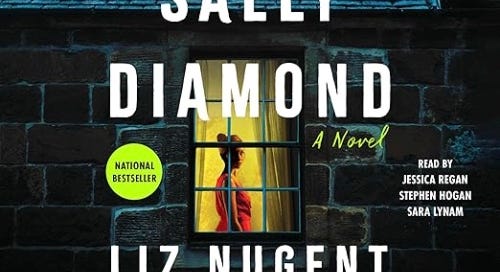BookLife Review by Carol O’Day: Strange Sally Diamond (Liz Nugent, author)
Crime, thriller, neuro-atypical protagonist, trauma victim, PTSD, kidnapping, unlawful detention of a minor, sexual abuse, teen pregnancy, pedophilia, investigation, healing.
BookLife Review by Carol O’Day: Strange Sally Diamond (Liz Nugent, author)
In Strange Sally Diamond, prolific Irish novelist, Liz Nugent, delivers a multi-tiered “backwards” crime story set in the outskirts of Dublin. She manages to forge a winning character and story out of the darkest of crimes. The story opens with protagonist Sally Diamond almost unwittingly committing a very odd and distasteful crime, but that crime was not the core dark crime of the novel. Immediately following the death of Sally’s father from a battle with cancer, Sally decides to incinerate his body in a metal drum on their property in which they ordinarily burned trash. Her act indisputably was a crime, but given Sally’s unusual mental limitations, and her penchant for taking most all statements literally (including her father’s exhortation to just “put him out with the trash”), her conduct lacked true criminal intent, and she was not prosecuted. Her limitations were due to the secret circumstances of her early childhood.
Sally Diamond was adopted after the death of her birth mother. Her birth mother, Denise Norton, had been kidnapped at age 11 by a pedophile and kept hostage in a locked room in the back of her captor’s house until she was in her mid-twenties. During her captivity, Denise was repeatedly raped and gave birth to two children, Peter and Mary Norton. Denise finally escaped when an attempted burglar heard her pleas for help and her captor fled the country with their son. Denise and daughter Mary, were hospitalized after her escape, but Denise could not overcome the severity and depth of her trauma and committed suicide. The resident treating psychiatrist and his physician wife adopted five year-old Mary and changed her name to Sally.
After Sally’s parents’ deaths and her initial arrest for unlawful mutilation of her father’s remains, the secret details of Sally’s early childhood are unearthed by the media. Sally has no memory of her early years and her parents had never shared the information with her. Her father leaves her letters with the details to be read after his death. Because of her trauma, Sally engages in unusual behaviors. She is extremely sensitive to noise, has difficulty socializing and reading social cues, views the world in black and white and interprets language quite literally. She was homeschooled and eschews social interaction. Sally has allies and guardian angels in her small town, friends and colleagues of her parents, who look out for her and attempt to guide her in the aftermath of her father’s death.
Sally is not prepared for the onslaught of attention that accompanies the revelation of her lurid past, and the information and attention re-traumatizes her. She seeks the help of a therapist and begins to emerge into the small world of her village.
Out of the blue she receives a package from New Zealand which contains a childhood toy. Despite the total repression of her memories, Sally is certain the toy is hers. With the arrival of the package, after more than three decades of cold trails, the hunt for the kidnapper and rapist who was her birth father resumes. Alone, damaged and confused, Sally forges ahead with the search and investigation, yearning for clarity, connection and closure. What she learns and finds presents a set of crimes and horrors no one anticipated.
Strange Sally Diamond is an odd and unusual sort of crime novel-the kind where the primary crime and the identity of its perpetrator is revealed early, and the novel becomes an unwinding of a past mystery. Its power is in the upfront demonstration of the damage the criminal, and the crime caused. The twists revealed only serve to darken and deepen the original sin. Sally is “Strange Sally Diamond” because of the harm done to her in early childhood. Over the course of the novel, she endeavors to heal and “normalize” herself, to adapt to social norms, develop friendships and the ordinary and casual interactions of everyday life. However, the darkness of the crime, its surviving tentacles and its further harms complicated the picture immeasurably. Sally heals, but the damage cannot be fully undone.
Please support BookLife: Reviews for Readers and independent book sellers by purchasing Strange Sally Diamond using the Bookshop.org link below.





